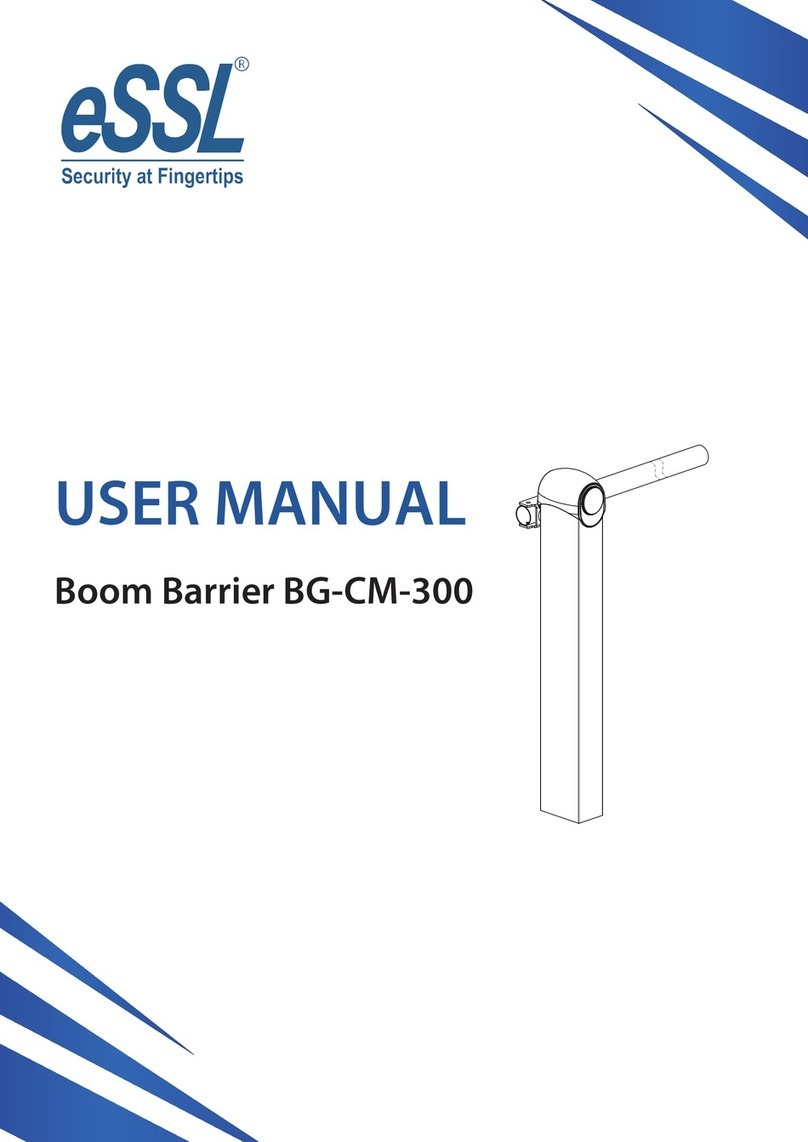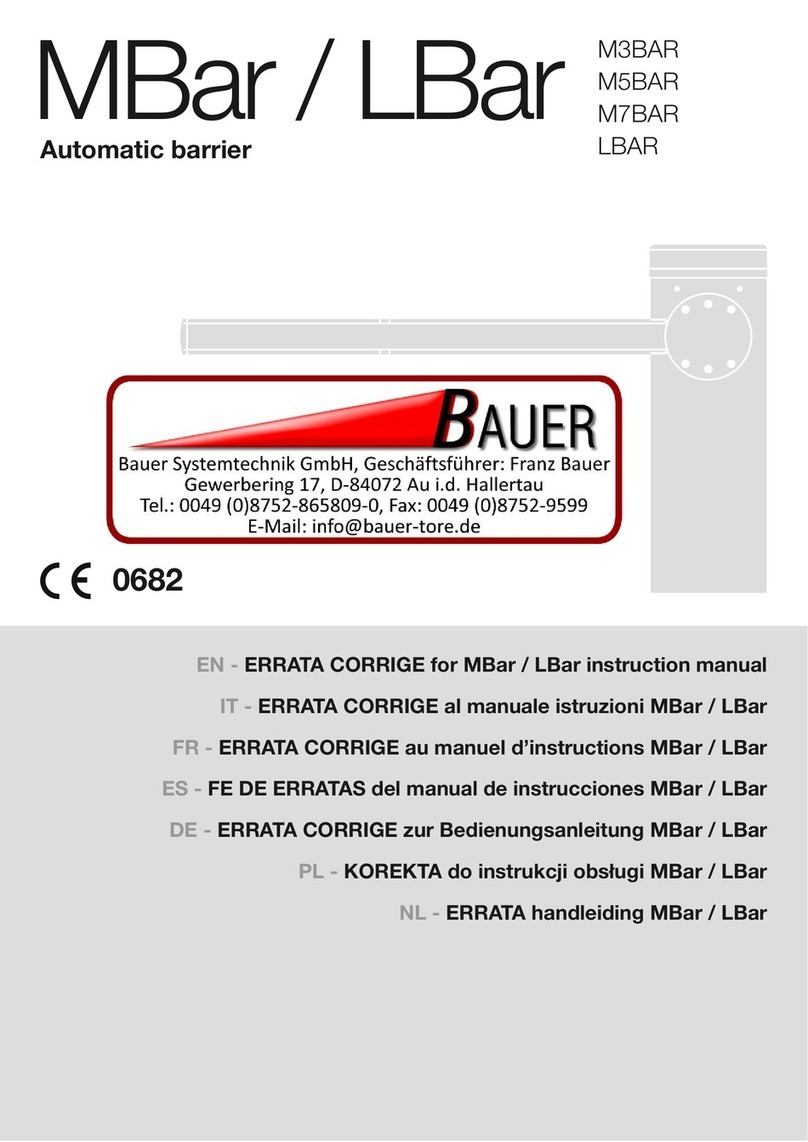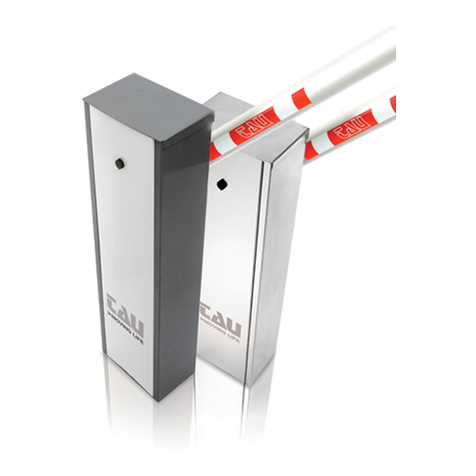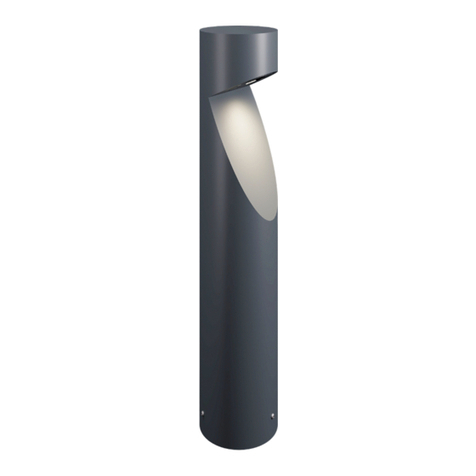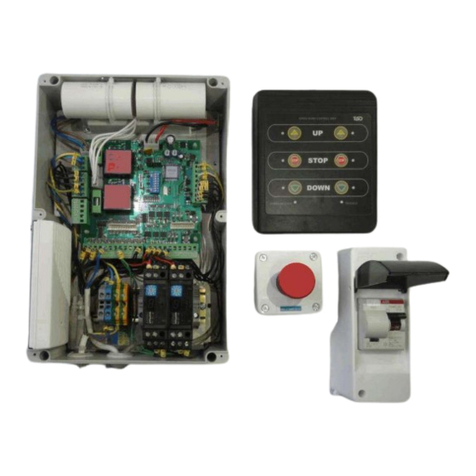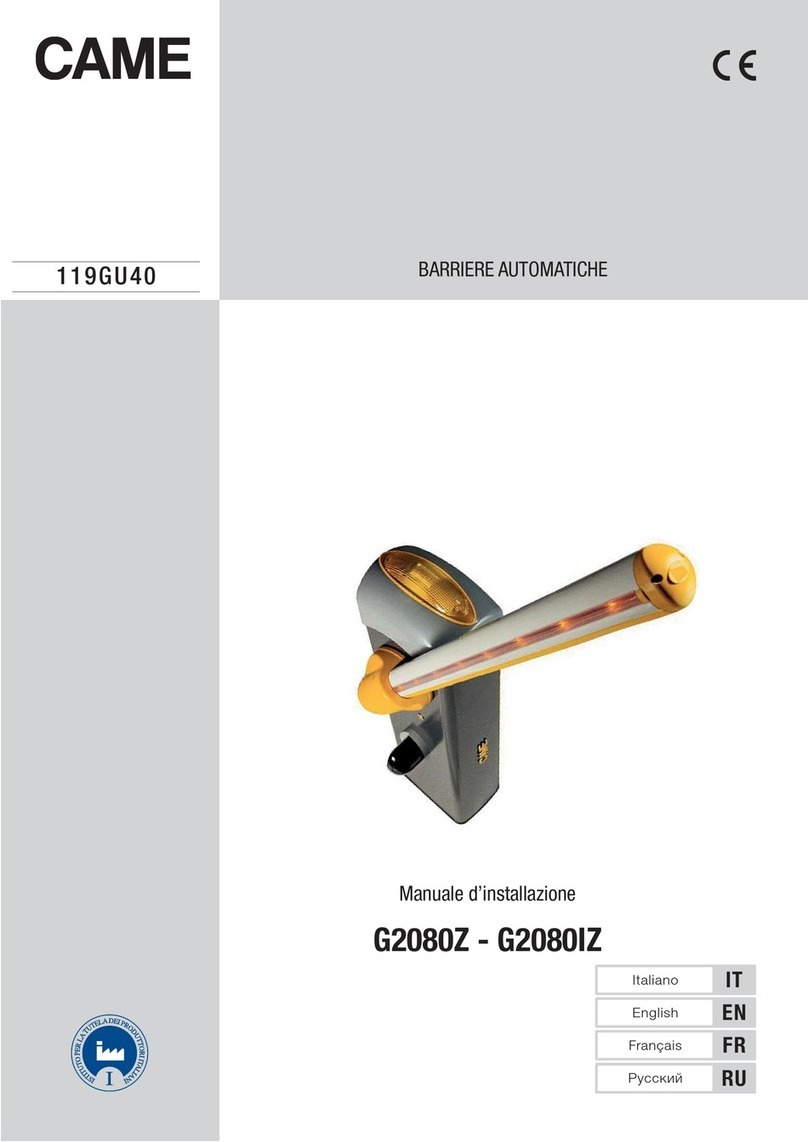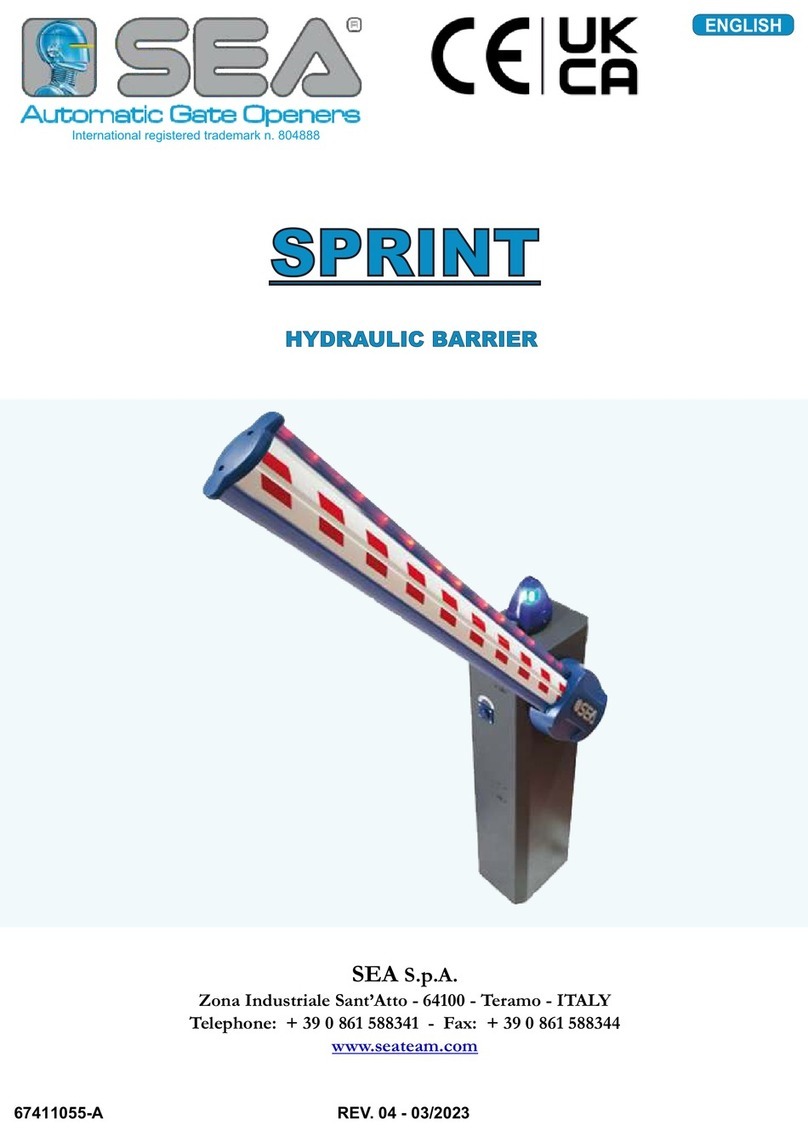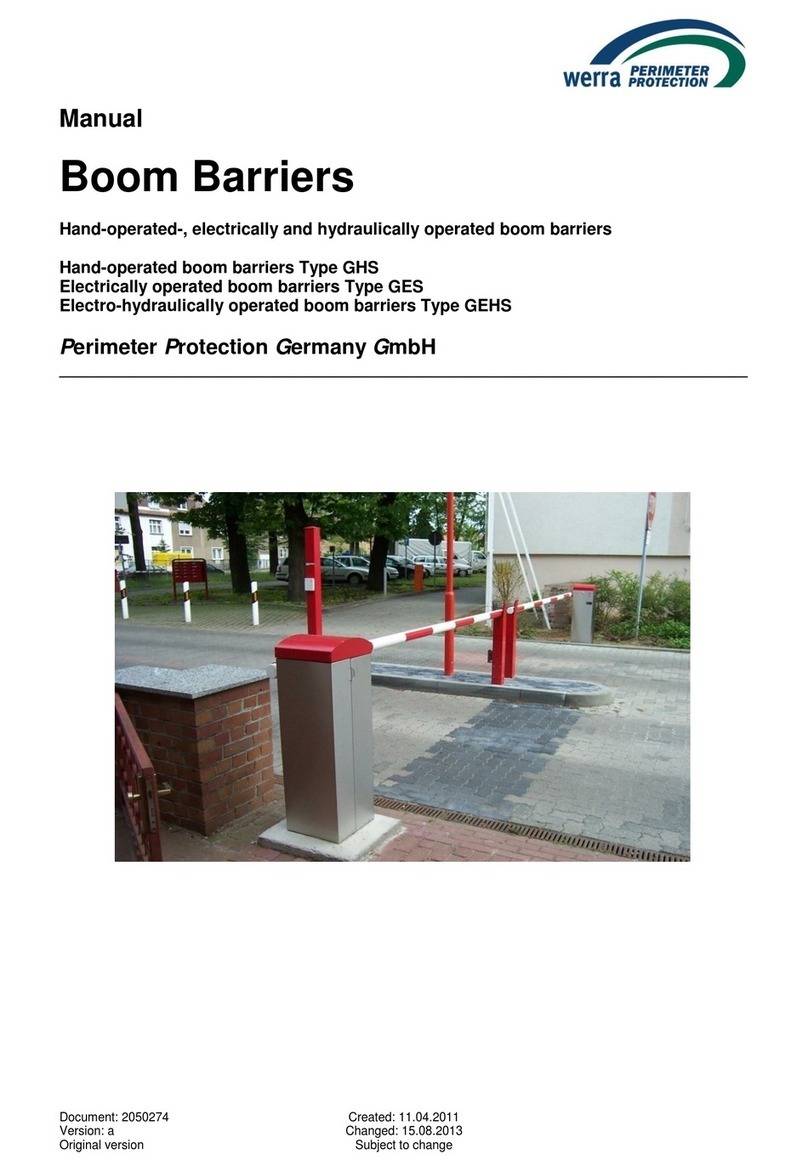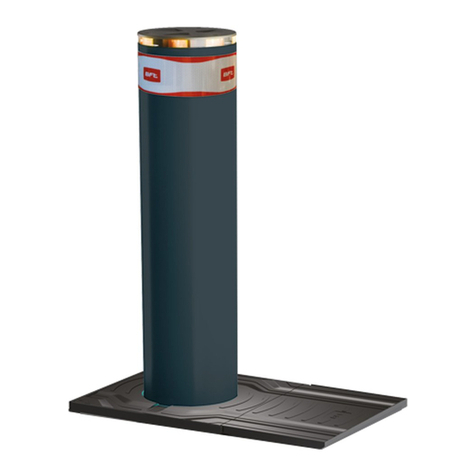Gibraltar G-4033P User manual

REV 1 Updated: 12/02/19
Gibraltar
G-4033P Portable Drop Arm Barrier
Owner’s Manual
Patent No: US 10,900,181
Gibraltar
4303 Innovation Loop
Marble Falls, Texas 78654
(Toll Free) 1-800-495-8957
(Office) 1-830-798-5444
(Fax) 1-830-798-5445
www.gibraltarus.com

REV 1 1 G-4033P Owner’s Manual
G-4033P M30 P3 Portable Drop Arm Owner’s Manual
Table of Contents
1. Introduction ..................................................................................................................................................... 2
2. System Description.......................................................................................................................................... 3
3. Safety............................................................................................................................................................... 3
4. Inspection......................................................................................................................................................... 3
5. Inventory.......................................................................................................................................................... 4
6. Storage............................................................................................................................................................. 4
7. Environment .................................................................................................................................................... 4
7.1. Environmental Capabilities.......................................................................................................................4
8. Product Installation.......................................................................................................................................... 4
8.1. Electrical....................................................................................................................................................4
8.2. Roadway Preparation ................................................................................................................................4
8.3. Barrier Placement......................................................................................................................................4
8.4. Controls.....................................................................................................................................................4
9. System Operation ............................................................................................................................................ 4
9.1. Barrier Operation.......................................................................................................................................4
9.2. Pre-System Startup Checks.......................................................................................................................5
9.3. Starting the System....................................................................................................................................5
9.4. Access Controls.........................................................................................................................................5
10. System Usage............................................................................................................................................... 5
10.1. Instructions................................................................................................................................................5
10.2. Manual Operation......................................................................................................................................5
10.3. Troubleshooting ........................................................................................................................................6
11. System Maintenance.................................................................................................................................... 6
11.1. Inspections / Cleaning...............................................................................................................................6
11.2. Preventative Maintenance .........................................................................................................................6
11.3. Visual/Audible Inspection (while cycling the barrier)..............................................................................6
11.4. Barrier Disassembly..................................................................................................................................6
12. Key Contacts................................................................................................................................................ 7
Appendix A - G-4033P Maintenance and Inspection Checklist............................................................................. 1
Appendix B –Spare/Replacement Parts................................................................................................................. 1
Appendix C –Deployment and Recovery.............................................................................................................. 1
Please Refer to Contract Plans and Documents for Specific Details.

REV 1 2 G-4033P Owner’s Manual
1. Introduction
This manual is intended as a supplement to project specific installation drawings and control system drawings.
Gibraltar’s M30 P3 Portable Drop Arm Barrier was designed to meet the most stringent specifications and
perimeter security standards for anti-ram vehicle barriers. The M30 P3 Portable Drop Arm Barrier system was
tested by a certified independent testing laboratory in accordance with ASTM F2656-07, Impact Condition
Designation M30, Penetration Rating P3, with capability of stopping a 15,000lb vehicle traveling at speeds up to
30mph. The M30 P3 Portable Drop Arm Barrier is listed and approved on the USACE Department of Defense
(DOD) Anti-Ram Barrier list.
The Gibraltar M30 P3 Portable Drop Arm Barrier is a great option for rapid deployment at locations such as
downtown corridors, festivals, stadiums, conventions, etc. that need hostile vehicle mitigation surrounding their
perimeter.
G-4033P (Towable configuration shown)

REV 1 3 G-4033P Owner’s Manual
2. System Description
The G-4033P M30 P3 Portable Drop Arm Barrier is designed in accordance with ASTM F2656-07 for an M30
P3 penetration rating with a blocking height of 43in (1092mm) from the roadway surface. It is a hydraulically
operated unit powered by a 12V battery source.
The G-4033P M30 P3 Portable Drop Arm Barrier is capable of 200 complete up/down cycles per hour and can
change direction when cycling. The cycle rate for opening and closing is adjustable.
The G-4033P M30 P3 Portable Drop Arm Barrier can be provided in a towable configuration as well. If
provided, the towable unit has a drop-down tongue permanently fixed to the barrier and a removable trailer that
can be towed separately for off-site storage or towing additional units.
Your Safety is Important to Us!
3. Safety
Gibraltar does not assume responsibility for injury to persons or property during loading, unloading,
transporting or installation, but verbal guidance and additional written instructions are available upon
request.
The installer is responsible for ensuring that the rigging and lifting gear is properly sized and attached when
lifting heavy components. The M30 P3 Portable Drop Arm Barrier can weigh as much as 8,000lbs
[2950kg]; use this weight for planning purposes. Equipment used to set system components must be capable
of handling the components in an overhang position.
Before working on any part of the system, ensure the following:
•Power is removed from the system.
•Traffic should be controlled for the duration of work performed on the barrier and should not be
permitted to drive through the system until all the control and safety functions have been verified
and are working properly.
•Use caution when working around the arm hinge or the latch, these are both dangerous pinch points.
4. Inspection
Upon delivery, the barrier should be checked to ensure that no damage occurred during shipping, e.g.
bent, misalignment, coating defects, weld defects.

REV 1 4 G-4033P Owner’s Manual
5. Inventory
Upon receipt, check your packing slip to ensure all materials arrived. Some equipment may be stored in
the barrier or tool cabinet.
6. Storage
The barrier shall be stored in such a manner to ensure proper ventilation and drainage, in addition to
protect against damage, weather, vandalism or theft.
7. Environment
7.1. Environmental Capabilities
7.1.1. The M30 P3 Portable Drop Arm Barrier is designed to operate in an ambient temperature range
of: 32 °F (0 °C) to 150 °F (65 °C).
8. Product Installation
8.1. Electrical
8.1.1. Power required for charging the battery system is 120VAC, 20A, 60Hz.
8.1.2. The M30 P3 barrier is capable of operating with on-board battery power only.
(See 9.2.1 for more power information)
8.2. Roadway Preparation
8.2.1. Any debris must be cleared prior to placing the M30 P3 Portable Drop Arm Barrier in position.
8.3. Barrier Placement
8.3.1. The M30 P3 Portable Drop Arm Barrier was designed to be deployed on a relatively level
concrete or asphalt roadway.
8.3.2. NOTE: For trailered barrier deployment, recovery, and operation, see Appendix C
instructions.
8.4. Controls
8.4.1. Once barrier is in place, locate the two-button remote control and pull out the desired amount
of cable.
9. System Operation
9.1. Barrier Operation
9.1.1. Gibraltar provides a basic two-button wired remote control capable of controlling a single
barrier. More complex control panels can be custom made at an additional cost.
9.1.2. Basic control functionality includes:
•Close pushbutton
•Open pushbutton

REV 1 5 G-4033P Owner’s Manual
9.2. Pre-System Startup Checks
9.2.1. Power
•Ensure all Electrical and Hydraulic connections are secure.
•Check battery charger LED to ensure the batteries are sufficiently charged. The barrier is capable
of over 300 cycles on a full charge.
oRed LED indicates low charge
oYellow LED indicates charging
oGreen LED indicated full charge
•The battery charger should be powered whenever possible. The connection plug is located in
the rear access box and normally attached to the provided generator. If the barrier is set up for
prolonged use, the power cable should be removed from the generator receptacle and powered
with a standard 120VAC, 20A power source.
9.2.2. Hydraulic Fluid Fill and Setup
•Fill oil reservoir with new filtered oil 1/2” from the top of the sight glass.
•Hydraulic fluid is not provided by Gibraltar, 1-2 gallons are required to fill the system, use
AW-46 type hydraulic fluid. Note: The trailered barrier version requires 2-3 gallons.
•Check for hydraulic leaks and tighten fittings as necessary.
9.2.3. Sensor Functionality
•The barrier is equipped with an optical beam sensor integrated into the control system. The
sensor prevents the arm from lowering if objects or personnel are under the arm.
9.3. Starting the System
9.3.1. Turn the power switch on the control panel to the ON position
9.3.2. Verify the green power LED is illuminated
9.4. Access Controls
9.4.1. Gibraltar can provide other control devices such as keypad entry, and wireless remote controls if
necessary.
9.4.2. In-field support for programming changes or additions is available for an additional fee.
Operation of the M30 P3 Portable Drop Arm Barrier can be
dangerous for installation and maintenance personnel, be aware of
pinch points when working on or near the barrier system.
10.System Usage
10.1. Instructions
10.1.1. Basic operation is via the pushbuttons on the two-button remote control or customer requested
entry method.
•To raise the barrier, press and hold the “up” pushbutton, the arm stops once the barrier is in
the up position.
•To lower the barrier, press and hold the “down” pushbutton, release the pushbutton once the
arm is down.
•Direction can be changed at any time by pressing the desired pushbutton.
10.2. Manual Operation
10.2.1. Switch the directional control valve to “raise”and use the hand pump to pump fluid into the
hydraulic cylinder to raise the barrier. It takes approximately 70-100 pumps using the hand pump
to raise the barrier fully.

REV 1 6 G-4033P Owner’s Manual
10.3. Troubleshooting
10.3.1. Check control panel to verify power.
10.3.2. If the barrier does not respond to control commands verify:
•All circuit breakers are on.
•No obstructions in front of the optical beam sensor.
10.3.3. If electronics appear to be functional, visually inspect the following for mechanical failures:
•Pivot Pin at the hinge post.
•Hydraulic Cylinder connection points.
•Hydraulic Cylinder Body.
•Verify the latch end of the arm is free from obstructions.
11.System Maintenance
11.1. Inspections / Cleaning
11.1.1. Cleaning in and around the barrier area should be, at minimum, every 3 months to avoid system
mechanical failure.
11.2. Preventative Maintenance
•Set barrier in desired position. If maintaining while in the
raised position secure the arm against the back stop.
•Turn the System power OFF. Lock the control box so power
cannot be reapplied.
11.2.1. Follow the G-4033P Maintenance and Inspection Checklist Appendix A.
11.2.2. See Appendix B for spare or replacement parts.
11.3. Visual/Audible Inspection (while cycling the barrier)
11.3.1. Listen for irregular noises around the blocking assembly for:
•Excessive banging
•Grinding
•Squeaking
11.3.2. Watch and listen to hydraulic cylinder for:
•Irregular movement (flexing or binding)
•Clicking
11.3.3. Check functionality of barrier face lights (while cycling barrier)
•LED strips should be green when the barrier is in the fully open position.
•LED strips should be red when in motion or when in the closed position.
11.4. Barrier Disassembly
•Lower the barrier to the roadway closed position.
•Turn the System power OFF in the control box. Lock the
control box.
These types of irregularities could be signs of more serious issues.

REV 1 7 G-4033P Owner’s Manual
11.4.1. Hydraulic drive system
•Bleed all pressure from the system through the system relief valve
•Remove hydraulic hoses from the cylinder
•Remove hydraulic cylinder clevis pins at the ram attachment points.
•Remove cylinder and inspect/replace as necessary.
•Re-assemble in reverse order
11.4.2. Barrier Arm Assembly
•Blocking assembly should not be removed from frame for the life of the product unless it is
determined to be necessary after consulting with Gibraltar.
•Support the arm assembly to prevent the assembly from falling once the pivot pin is removed.
•Remove all clamps and the pivot pin
•Lift arm out of buttress assemblies.
•Re-assemble in reverse order.
11.4.3. Arm Assembly Lights
•LED strips can be disconnected by pulling power wire out of the arm assembly and
disconnecting lights at screw on/off connection lead.
•Slide LED strip out towards the latch end of the LED track.
•Re-install in reverse order.
12.Key Contacts
Technical / Sales Support
Gibraltar
4303 Innovation Loop
Marble Falls, Texas 78654
1-800-495-8957 (toll free)
1-830-798-5444 (office)
1-830-798-5445 (fax)
www.gibraltarus.com

REV 1 A1 G-4033P Owner’s Manual
Appendix A - G-4033P Maintenance and Inspection Checklist
G-4033P Maintenance and Inspection Checklist
G-4033P Common Inspection and Maintenance Checklist
This checklist is used to maintain the quality of your Gibraltar G-4033P Portable Drop Arm in accordance with Gibraltar’s
standards and Warranty requirement.
Date:
Facility Name:
Inspector:
Barrier Serial:
Required inspection and maintenance points at 10,000 cycles or 3 months of operation:
Inspection Areas
Comments
Pass
Fail
2. Visually inspect all bushings at the hinge point
3. Visually inspect hydraulic cylinder attachment bracket
4. Visually inspect hydraulic cylinder body for damage
5. Visually inspect the connection points of the cylinder
8. Verify all bolts are snug and have not worked themselves loose
10. Verify Hydraulic cabinet and any junction boxes are free from debris
11. Verify no loose wires within Hydraulic cabinet or any junction boxes
12. Inspect barrier buttress posts for paint coating conditions
13. Cycle minimum 10 times
14. Verify smooth operation without binding
15. Ensure barrier rests on stop plate at the latch end when lowered
G-4033P Hydraulic 10,000 cycle or 3 months of operation maintenance checklist:
1. Complete first section of this checklist
2. Visually inspect for proper fluid level
3. Inspect for fluid leaks in cylinder area
4. Check all hydraulic fittings within HPU for leaks
G-4033P Hydraulic 30,000 cycle or 12 months of operation maintenance checklist:
1. Perform typical 10,000 cycle, 3-month inspection
2. Check hydraulic fluid condition
3. Visually inspect hoses for excessive wear
Inspector Signature: _______________________
Date:
_________________

REV 1 B1 G-4033P Owner’s Manual
Appendix B –Spare/Replacement Parts
SPARE/REPLACEMENT PARTS
Part #
Item / (Description)
4152-BUSHING
G-4033P Drop Arm Pivot Pin Bushing
4000-LED-12
12Ft. Clear Opening Drop Arm LED Strip
4000-BMPR
Drop Arm Bumper Pads
HYDCYL-2X16
G-4033P Hydraulic Cylinder
CLEVIS-HD
Hydraulic Cylinder Clevis Pin
Contact Gibraltar (+830-798-5444) if replacement parts are required.

REV 1 C1 G-2000 Owner’s Manual
Appendix C –Deployment and Recovery
Back barrier into desired deployment area, DEPLOY
trailered barrier as follows:
1. Remove the pins from the three hydraulic risers (2
tongue side, 1 rear)
2. Unlock and open the control cabinet top cover
3. Turn the main power switch ON, the green LED
indicator light will illuminate
4. Ensure the mode selector switch is in TRAILER
mode.
5. Ensure the Riser/Arm selector valve is in RISER
6. Lower the tongue and rear risers until they contact
the ground
7. Disconnect the barrier tongue from the tow vehicle
8. Remove the tongue support bar, fold and pin the
barrier tongue in the stowed position
9. Store the tongue support bar inside the trailer
storage box
10. Raise the front and rear hydraulics until the trailer
tires are off the ground
11. Move the tow vehicle away from the Drop Arm
12. Raise the arm to the full up position
13. Disconnect the brake quick disconnect fitting from
the barrier tongue
14. Disconnect the trailer light wire extension and store
it in the trailer storage box
15. Pull the light cable and brake line through the pass-
through tubes
16. Coil the trailer brake line and stow it with the rubber
tiedown on the front of the trailer frame
17. Remove the pin retaining the trailer tongue
extension and extend the trailer tongue
18. Pin the tongue extension in the extended position
19. Remove the turn table (if required) and positioning
bar from the trailer storage box
20. Using the combination wrench and adjustable
wrench stored in the trailer storage box, remove the
four 1-inch bolts connecting the trailer to the drop
arm
21. Store the bolts and wrenches in the trailer storage
box
22. Lower the barrier, alternating the tongue and rear
riser control valve, until it is sitting on the ground
23. Lift the tongue of the trailer and extend the jack
wheel
24. Chalk the rear of the driver side trailer tire
25. Using the driver side tire as a pivot point, pull on
tongue extension from the driver side to roll the
trailer off of the barrier.
26. Turn the mode selector switch to the BARRIER
position, the green LED indicator light will illuminate
27. Move the Riser/Arm selector valve to the ARM
position
28. Insert the pin side of the positioning bar into the
sleeve in the center of the ramp, lift the ramp
vertical, remove the positioning bar, and push the
ramp into the deployed position
29. Lower the arm, extend the desired amount of cable
for the pushbutton control, and close the top cover
30. If possible, start the generator or connect the battery
charger cable to 120V, 20A line power to charge the
batteries
31. The barrier is ready for use
CONTINUE TO THE NEXT STEP IF THE
BARRIER MUST BE ROTATED
32. Move the Riser/Arm selector valve to the RISER
position
33. Raise the barrier approximately 6” evenly off of the
ground
34. Position the turn table under the barrier with the
hook on the positioning bar
35. Lower the barrier onto the turn table (steps 32 - 34
may need to be repeated to find the center of gravity
of the barrier)
36. Retract tongue and rear risers enough to clear the
ground, the barrier should be balanced on the turn
table
37. Rotate the barrier into the desired position
38. Raise the barrier and remove the turn table, store it
in the trailer storage box
39. Lower the barrier into position and retract the risers
40. The barrier is ready for use
WARNING: NEVER place any
part of your body under the
barrier, loss of hydraulic pressure
could result in severe injury or
death.
CAUTION: The turn table is
intended to be used on level well
compacted surfaces such as
concrete and asphalt.

REV 1 C1 G-2000 Owner’s Manual
RECOVER the trailered barrier as follows:
1. If the barrier was rotated using the turn table,
accomplish steps 31 –37 before continuing.
2. Ensure the mode selector switch is in TRAILER
mode
NOTE: With the mode selector switch in trailer
mode, the riser control pushbutton will time out
when retracting the risers. It will be necessary to
press the button multiple times until the desired
position is reached
3. Move the Riser/Arm selector valve to ARM
4. Raise the drop arm to the fully open position
5. Move the Riser/Arm selector valve to RISER
6. If line power was connected to the battery charger,
remove it at this time.
7. Back both of the trailer tires against the driver side
of the barrier into the same position it was removed
during deployment
8. Chalk the front of the driver side trailer tire
9. Using the driver side tire as a pivot point, pull on
tongue extension from the passenger side to roll the
trailer onto the barrier.
10. Fold the trailer jack and position the trailer over the
mounting holes in the barrier
11. Raise the barrier evenly until the trailer frame is
almost level and the tires still touch the ground.
12. Align the trailer to allow the 1” bolts to be inserted
through the trailer mount holes and barrier
13. Raise the barrier until the trailer wheels are off the
ground
14. Install the washers and nuts on the 1” bolts and
torque to 300 ft-lbs
15. Retract and pin trailer tongue
16. Connect the trailer light extension to the light cable
17. Feed the hydraulic brake line and light cable
through the pass-through tubes
18. Reconnect the hydraulic brakes to the tongue
connection
19. Move the Riser/Arm selector valve to ARM
20. Lower the drop arm
CAUTION: When lowering the drop arm in trailer
mode, push and hold the down button until the arm
is completely closed, do not release the button until
the arm is resting on the rubber stop
21. Stow the turn table and positioning bar back in
trailer storage box
22. Move the Riser/Arm selector valve to RISER
23. Retract the rear riser and install the pin
24. Unpin the barrier tongue and re-install the support
tube onto the tongue
25. Position the tow vehicle and lower the tongue onto
hitch using the risers
26. Retract the front risers and install the pins
27. Stow the pushbutton control and cables back inside
the control cabinet
28. Turn the main power switch OFF, close and lock the
top cover
29. Check to ensure all connections are made to the
tow vehicle
30. Perform a final walk around of drop arm trailer to
ensure:
a. No parts or tools are left on the trailer
b. All risers are retracted and secured
c. All trailer lights are properly functioning
d. Trailer coupler is properly seated, latched,
and pinned
e. Safety chains are attached
f. Brakes are correctly connected to the
tongue
31. Verify the trailer brakes are functioning properly by
accelerating to approximately 10 MPH, apply the
brakes, and verify the hydraulic brakes are stopping
the trailer
WARNING: The MAXIMUM
tow speed of the Drop Arm
Barrier is 55 MPH with a 1 Ton
truck or larger and 45 MPH with
smaller vehicles. DO NOT
exceed these speeds.
Table of contents
Popular Automatic Barrier manuals by other brands
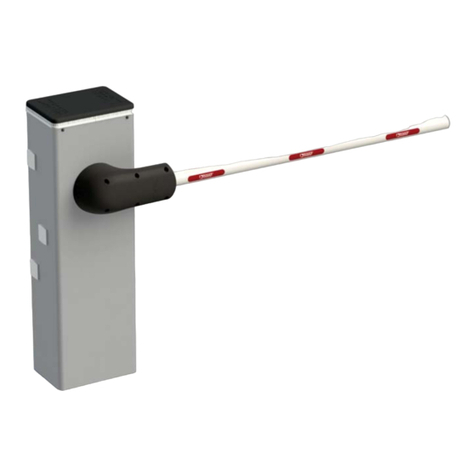
Roger Technology
Roger Technology BI/001PC Instruction and warnings for the installer
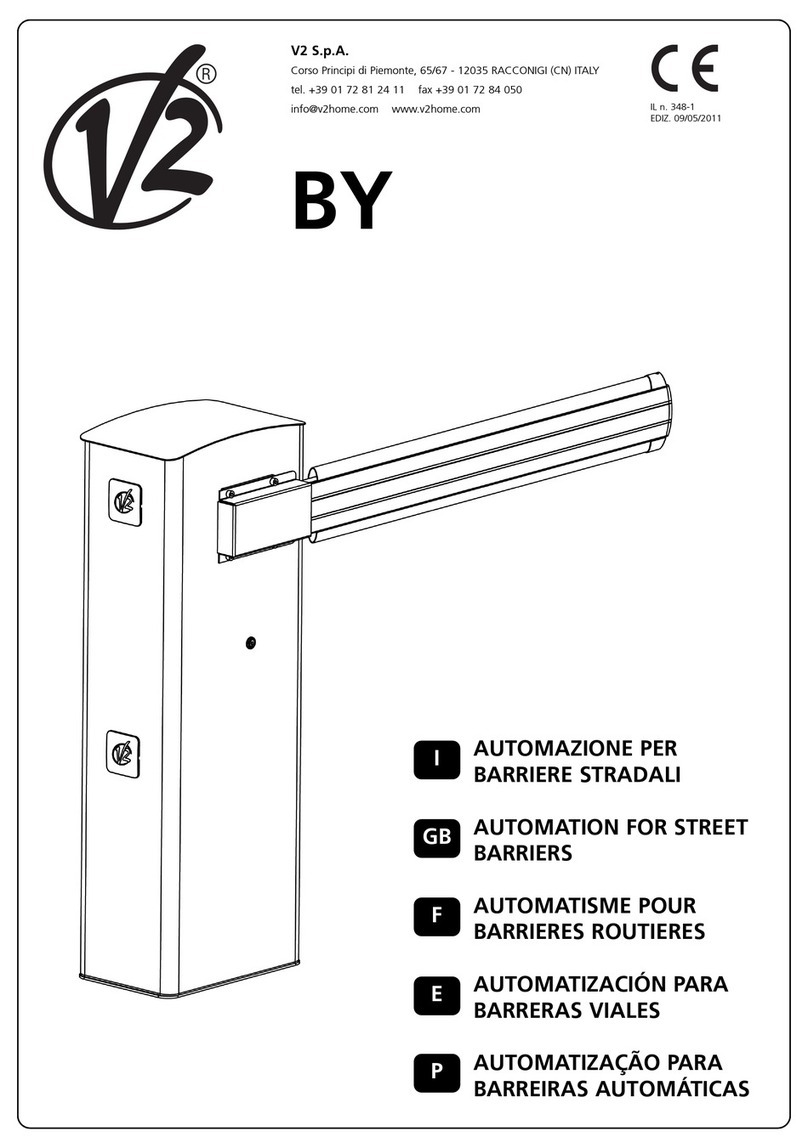
V2
V2 BY Series instructions
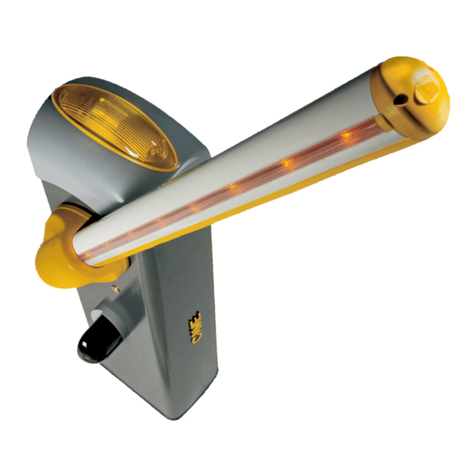
CAME
CAME G4040EZ Installation and operation
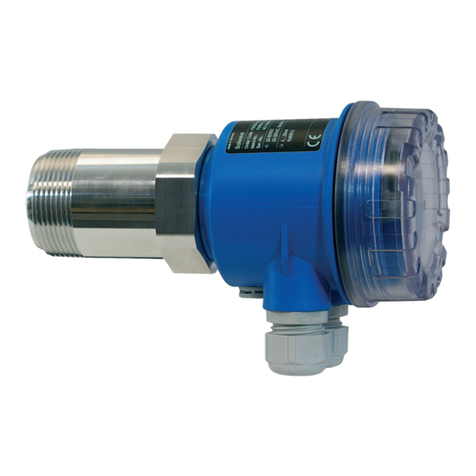
Endress+Hauser
Endress+Hauser Soliwave FQR56 operating instructions

CAME
CAME GARD series installation manual
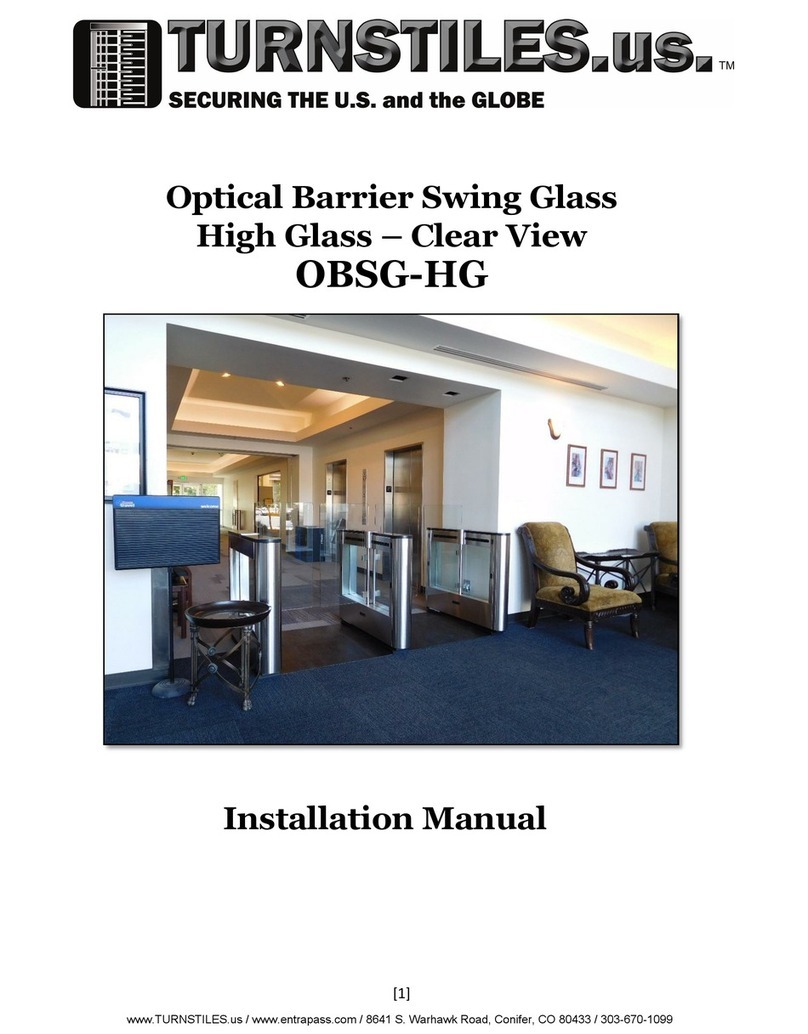
Turnstiles
Turnstiles OBSG-HG installation manual
